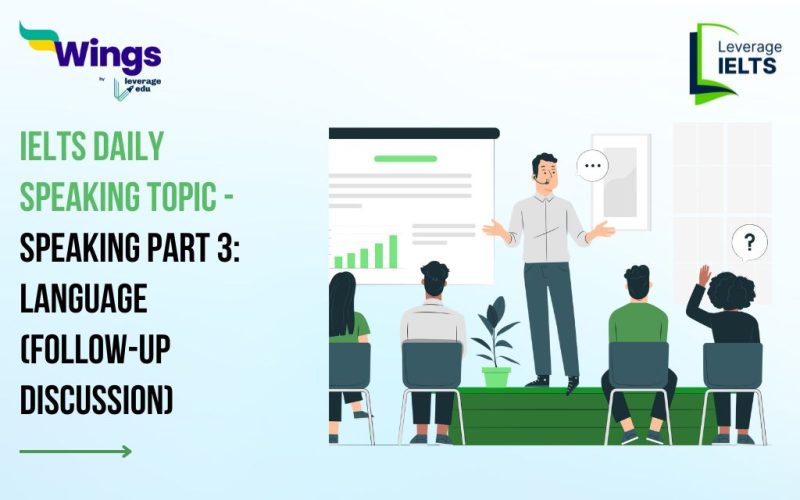Discussion Topics
- Language and Technology
- Bilingualism and Multilingualism
- Language Learning in Schools
Follow-up Questions
1. Language and Technology
Q.1. How has technology influenced the way we communicate in different languages?
Ans. Technology has completely transformed the way people communicate across different languages. With the advent of the internet and social media, people from all over the world can now connect instantly, regardless of language barriers. For example, social media platforms like Facebook and Instagram have built-in features that allow users to read posts and comments in their preferred language. This means you can easily follow a friend’s life in another country, even if you don’t speak the same language.
Moreover, video conferencing tools like Zoom have real-time translation and transcription features. Whenever I needed to talk to my colleagues living internationally or during my online classes in college when my teacher communicated in a different language, these features were incredibly helpful. It’s fascinating how technology has made it easier to share ideas and collaborate globally.
Q.2. What are the pros and cons of using translation apps?
Ans. Translation apps such as Google Translate have become incredibly popular because they offer quick and easy language translation. One of the major advantages is convenience. For example, one time I was travelling in a foreign country, so translating apps was my only support. It helped me translate signs, and menus or have a basic conversation with the natives. It was like having a personal translator in your pocket.
However, there are some disadvantages too of these apps. While translation technology has improved a lot, it is not perfect. There are often mistakes, especially with complex sentences or idiomatic expressions. For instance, a phrase like “it’s raining cats and dogs” might get translated literally, confusing. So, while translation apps are fantastic tools, they should be used as a supplement to, not a replacement for, actual language learning.
2. Bilingualism and Multilingualism
Q.1. What are the benefits and challenges of being bilingual or multilingual in today’s world?
Ans. Being bilingual or multilingual has some amazing benefits. One of the biggest benefits is improved communication. When people speak multiple languages they can connect with a wide range of people whether they are travelling, working or just making friends. For example, one of my friends knows both English and Spanish and once she went to America and then she told me that she felt that she could easily navigate through most parts of America because of this.
However, there are various challenges one can face. One of the common issues is language interference, where words from one language can come into conversion into another language, which can be very confusing. For example, one might accidentally use a French word while speaking Spanish.
Q.2. How does being fluent in multiple languages affect one’s career opportunities?
Ans. When one is fluent in multiple languages, it can significantly boost career opportunities. Many companies operate on a global language. For example, one of my close friends can speak both Mandarin and English and now she works with a multinational organization that has offices in both China and the US, facilitating communication and business deals between the two regions.
Additionally, being multilingual can open doors to specific careers like translation, interpretation, and international relations. These fields often require fluency in multiple languages and offer exciting opportunities to travel and engage with different cultures.
3. Language Learning in Schools
Q.1. Should schools focus more on teaching foreign languages? Why or why not?
Ans. I think that schools should focus more on teaching foreign languages. In today’s globalized world, knowing more than one language is such a valuable skill. It opens up so many opportunities for students, whether it’s for travel, work, or understanding different cultures. For example, someone who learns Spanish in school can communicate with millions of people across Latin America and Spain, which is a huge advantage in many fields.
Q.2. What are the most effective methods for children to learn a second language?
Ans. There are several effective methods for children to learn a second language, and the key is to make the learning process engaging and immersive. One great approach is through interactive activities and games. Kids learn best when they’re having fun, so incorporating language games, songs, and stories can make the experience enjoyable and memorable. For instance, using apps like Duolingo that turn language learning into a game can be effective.
Apart from that, it’s crucial to be patient and encouraging. Learning a new language can be challenging, and kids need to feel supported and confident. Celebrating their progress, no matter how small, keeps them motivated and eager to learn more.
Are you preparing for IELTS? Check out this video to improve your speaking skills for the IELTS exam given below👇.
Download the Leverage IELTS App today.


Need help to prepare for IELTS? Check out the best IELTS preparation courses in the market offered in a live training environment by trusted educators in a live training environment. If you want help studying abroad, call 1800-572-130.
 One app for all your study abroad needs
One app for all your study abroad needs















 60,000+ students trusted us with their dreams. Take the first step today!
60,000+ students trusted us with their dreams. Take the first step today!